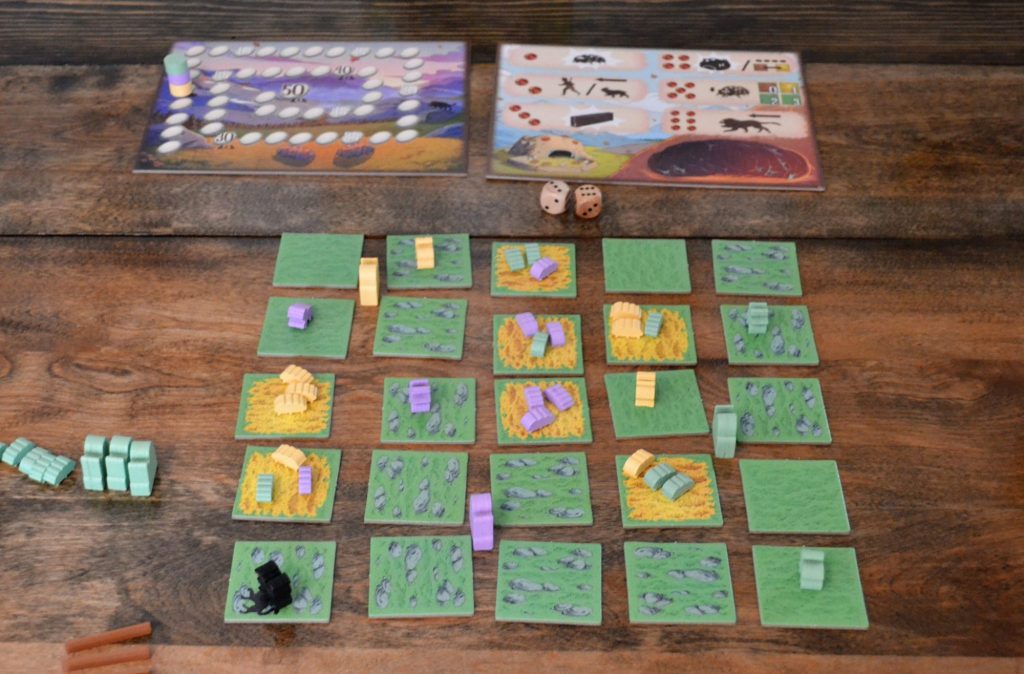Disclosure: Meeple Mountain received a free copy of this product in exchange for an honest, unbiased review. This review is not intended to be an endorsement.
Silk is a farming game where players work to protect, grow, and feed their precious flock. Well, flock may not be exactly the right word, since in this game the animals you’re farming aren’t sheep, they’re silkworms. Another aspect that makes Silk unique from other farming games is that at its core it’s an area control game. Players want to have their silkworms on the greenest pastures in order to get the most points. So while having the most silkworms might help you out, the game is more about having them on the best spots.

How it works
In Silk, players compete to get the most points. While there are several ways points are awarded, the majority come from grazing your silkworms on fertile land. Silk begins with three types of terrain tiles: dry pastures, normal pastures, and the highly coveted leafy pastures. As you may have guessed, the better the pasture, the more points it is worth.
All players have a flock of silkworms in their own colour, as well as other pieces that herd and create new silkworms. A player’s turn will often consist of some mix of grazing, herding, and building. Naturally, you’ll want to move your own silkworms towards lucrative grazing grounds, but it’s often just as good to herd your opponents’ worms into trouble. The tricky thing is, you won’t always be able to do exactly what you want — at least, not without paying a price.
Silk uses dice to determine what actions you’re able to play on your turn; each number corresponding to a specific action (ex. rolling a 5 triggers a grazing action). To mitigate the randomness from this mechanic, Silk offers players some flexibility: the result from a die can always be changed up or down, but each step away from the rolled value will cost one point. This means players will never be cheated out of a much-needed move by a bad roll.
Before the dice are rolled, players also spawn a new worm. So a player’s turn consists of three steps:
- Spawn a new silkworm onto the board (more on that later)
- Roll the dice
- Based on the results of the roll, conduct two actions
Actions in Silk
Each number on Silk’s dice corresponds to an action. To get a better idea how Silk’s gameplay works, here’s an overview of the actions.

Spawning Worms: At the start of every turn, the active player must spawn a new worm. This is also an action you can roll on the dice. Worms can spawn on any tile that already has at least one of the player’s silkworms or is adjacent to a nursery.
Nurseries are the second type of player-specific piece in Silk. Unlike the silkworms, nurseries are placed between tiles — as such, each Nursery will be adjacent to four tiles (or two, on the edge of the board).
Grazing: The graze action is the largest source of in-game points. During a graze action, the active player chooses a tile with at least one of their silkworms. The active player gains points based on how many worms they had on that tile and how lush the farmland is — opponent worms don’t get any points during the grazing.
After the worms eat the tile is flipped over to the Barren side, which is worth no points during grazing.
All the worms are now moved to adjacent tiles — and this includes any opponent worms that were there! The active player gets to choose what tile each worm ends up on, which is a great opportunity to send your opponent’s worms over to garbage island. You can even push opponent worms right off the edge of the board. This means that while grazing is an important source of points, it’s also a way to control worm movement and positioning for future turns. Note that each tile can only hold three worms.
Build New Nurseries (or Rejuvenate Tiles): Players start the game with only one nursery. To spread out their control over the board, this action lets players build a new one. If you’ve already built all four of your nurseries, this action allows you to rejuvenate a barren tile adjacent to one of your nurseries, flipping it over to whatever it was before. The tile does have to be empty to do that, which means it happens less often than you would expect.
Nurseries have to be built a Catan-length away from any other nursery — some people would call that “two steps”. They also have to be built beside your shepherd. Speaking of which…
Move a herding piece: Silkworms aren’t the only pieces in the game that can move. Players are also in control of two important pieces: their shepherd, and their mastiff.
Each of these pieces serves a similar function — they herd worms. By moving a shepherd or mastiff into a space with silkworms, those worms get bumped and redistributed to adjacent tiles. This is where Silk becomes a little more aggressive: players often move their own shepherds and mastiffs in order to bump opponent worms to less desirable locations. Players may also use their herding pieces to block spaces, since no worm can ever move into a shepherd or mastiff-occupied tile.
There is one more element at play. The shepherd and mastiff have an interesting relationship when it comes to movement, but we can’t talk about that until we talk about…
Move the Ookami: What would a herd of sheep be without a wolf? The Ookami is a communally controlled monster that eats silkworms. Any silkworms on a tile with the Ookami are immediately moved to the Ookami’s den, which will lose the victim points at the end of the game.
Using this action, the active player can move the Ookami one space in any direction, gobbling up any silkworms that were there.
Sidenote — some quirky movement rules: Okay, this isn’t an action, but it’s an important piece of bonus info. The shepherd bumps the mastiff, who bumps the Ookami, who bumps the shepherd. What this means is that, on your turn, you could end up triggering a whole bump-a-thon of your own and opponent pieces until you’re in just the right place to gobble up those opponent silkworms — or bump your own worms to the perfect spot.
Oh, one more thing: Silk operates with Pac-Man style wraparound movement, which means nobody’s stuck in a useless corner forever. Well, unless they’re blocked by walls.

Build a wall: Last action, and the most niche. Players can build a wall between tiles, starting from one of their nurseries. This serves a couple of functions: first, a wall that runs from one nursery to another grants points to the player who placed the last piece. Second, only a shepherd can cross walls, meaning that players can use walls to protect their pieces (and keep their opponent pieces in low-value spots). Third, fully walled-off tiles (called enclosures) grant points at the end of the game to the player with the most nurseries attached to the wall. This is probably the most difficult strategy for new players to pick up on, since it requires a long term commitment.
Extra Points and End Games
In addition to points from grazing and walls, Silk offers a few enticing rewards to the first player to complete certain goals. Points are awarded to the first person to place all their silkworms, as well as the first person to place all their nurseries. There are also bonus points for the first person to build a five piece long, uninterrupted wall, and finally, to a player who completes a three tile-large enclosure.

These points are important, because it’s one of the ways that the game ends. When the first person hits a certain point threshold (variable based on player count), this triggers the last round. Game end is also initiated when players run out of fences, or if all tiles are flipped to barren. In my experience, that last one almost never happens.
When the game ends, there are some more points to be had. All enclosures score points: their size, multiplied by the amount of nurseries from the majority player along the fence, gives the point value. Any silkworms left on fertile land will also graze one last time, without the movement action that would usually accompany it.

Thoughts
This is one of the few area control games I actually enjoy. When I first read the rules, I knew I wanted to try it. My initial thoughts before playing the game was that it reminded me of Barony (the other area control game I enjoy) and Agricola: All Creatures Big and Small. Silk manages to have the delightful theme of a farming game with the cutthroat actions of an area control game, and it works really well.
One of the aspects that I enjoy most about Silk is that your actions are shaped by the rolls you make on your turn, but not limited to them. Often in area control games, I find that they are too close to abstract strategy for my taste. You end up thinking of all the possible moves the other player might make and what you can do to counter them. In Silk, any of the actions are fair game, but it’s less likely that you’ll make a move just to mess with the other players if it will cost you a few points to do so.

All in all, I think this game is quite good, but there are some definite flaws; the first being the level of ambiguity in the rulebook. While playing the game, various players had many questions that came up regarding certain rules. We reached out to the publisher and received answers to our questions. For those of you who want to know, we’ve posted a Rules FAQ on BGG.
More troublesome than the rules ambiguity is what I believe is a printing error. The game states that a 4 player game ends at 50 points, a 3 player game at 40, and a two player game at 30. When playing the 4 player version, we never finished the game. The area scales up with the players, and scaling the points up with the player count causes a never ending game. We actually just had to call it after around 2 hours (of a 45 minute game). Another 4 player game with a different set of players led to the same conclusion: the game lasted hours without tracking towards a natural end. On a hunch, we played a 4-player game to 30 points, and lo and behold the game ended satisfyingly in around 45 minutes.
We also tried the recommended 2 players to 30 points, which led to a game that was over very quickly. Our conclusion is that these two end game conditions have been switched. We’ve contacted the publisher and I expect there will be an errata coming out on this topic. And if there’s not, I suggest you play as if there was, because it really is a good game when it lasts its projected length.
Finally, I couldn’t end this review without talking about the beauty of this game. From the game art, to the unique meeples and the pastel player colours, this game is gorgeous. For the small box that it comes in, you are getting a lot of production value. The only thing it is missing is a player aid for what pieces bump/herd what. This is ultimately minor, and doesn’t take away from the adorable silkworm animeeples.

Silk’s imaginative and beautiful design, varying mechanics, and random set-up gives it staying power. I’m happy to announce that Silk has found a home on my shelf and I’m looking forward to having another area control game that I actually really enjoy.
UPDATE: The publisher has responded to our review to clarify that the ending conditions (50 for 4 players, 40 for 3 players, 30 for 2 players) are an intentional design decision. We respect their creative choices, but would suggest that readers consider switching the 50 and 30 point end goals for what we felt was a more satisfying experience.
Six Month Update
Surprisingly I’ve only played Silk once since the review. It’s a good game, I’m just not often in the mood for aggressive area control games. But when I am, I’m sure Silk will be the first game I go for.












I absolutely agree about the point system being flawed, and I’m stunned the publisher wants to keep it as is. It was immediately obvious there was something wrong on our very first 2-player game, and we changed to 50 pts for 2 players. Much better.